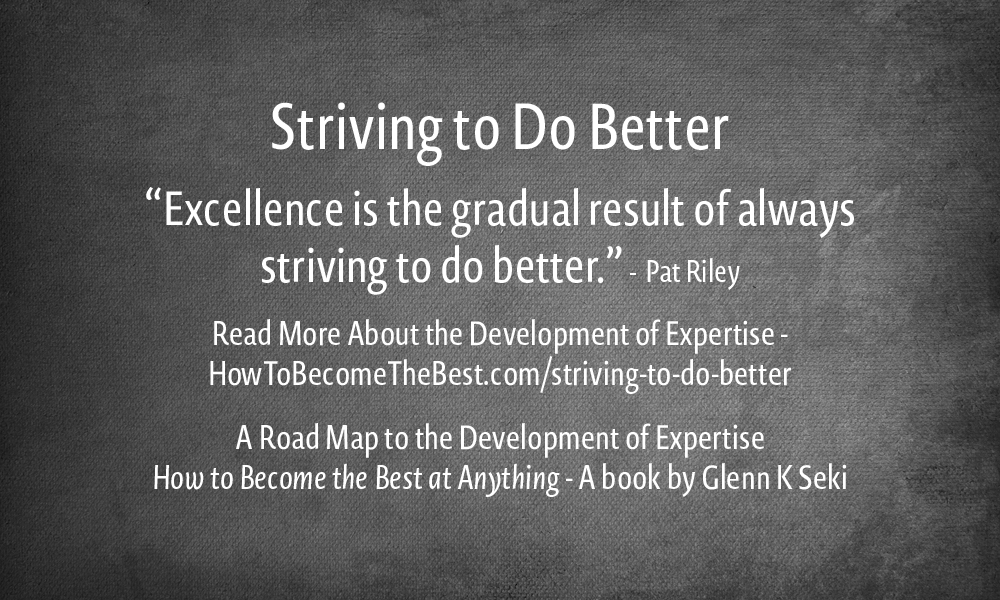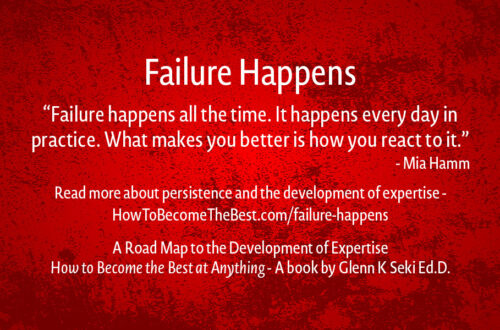“Excellence is the gradual result of always striving to do better.” – Pat Riley
An excerpt from How To Become The Best at Anything, Chapter 8, Deliberate Practice and Learning
“To become the best takes practice, lots and lots of practice. I have mentioned the 10,000-hour rule. It takes about 10,000 hours of practice to get really good at something and not just any type of practice, but deliberate practice. Deliberate practice is practicing to get better.
The classic example is a man who has gone golfing almost every weekend for the past twenty years. He has a great interest in the sport and has fun with it. He reaches a certain level of expertise and plateaus there after about seven years. He is good enough to win occasionally playing, against his friends. He has fun, although after twenty years of practice why hasn’t he become a great golfer? Because he was not practicing to get better, he was not using deliberate practice, he was just participating in the sport. When you practice, you need to be practicing something that will help you become better.
10,000 hours of practice comes out to about 5 to 6 hours a day, 4 to 6 days a week, for 7 to 10 years of deliberate practice. That’s what it takes to become one of the best, depending on the domain. This is a lot of deliberate practice!
What if you want to become the best in a domain that is a new sport or profession? If levels of expertise have not been fully established, then you can become the best in far fewer hours of deliberate practice. This is because no one has practiced and established themselves in the domain yet. The bar of expertise is being reset all the time. As time goes by, the 10,000 hours will be reached, and fully automated sequences will be in place making it harder for novices to attain high levels of expertise. Those that started first in the new sport or profession, as long as they continue to improve, will remain on top.”
Automaticity
“Deliberate practice results in the automation of a sequence of steps. It is automated so you don’t have to consciously think about it while you are doing it, you just do it. Some people call this “muscle memory.” I don’t like this term since muscles have no memory. Repeat after me, “muscles have no memory.” This automated sequence of steps is in your memory, in your brain. Your brain places this automated sequence of steps into nice and neat “chunks,” so you do not have to consciously think about them.
Remember when you were first learning to drive a car. It was very difficult and stressful because you had to remember to do so many new things at the same time. Most DMVs require a minimum of 50 hours supervised behind-the-wheel experience before you may apply for a license if you are under 18. It takes 100 hours of deliberate practice before a complex sequence begins to fully automate. That is why it is so difficult in the beginning to drive a car in traffic.
Now that you have been driving for several years, when you are commuting home after work, you probably don’t think about driving, you suddenly find yourself at the freeway off-ramp and almost home. That is because your diving has become automated, if something unusual occurs, you instantly snap back into conscious thinking mode and make corrections to your driving.
This is also why you must practice good driving habits in the beginning, so you don’t automate a bad habit. Once a bad habit is automated, it is very hard to un-automate it and replace it with the correct automation. Learn the basics correctly the first time. This goes for all practice, for all domains.”





